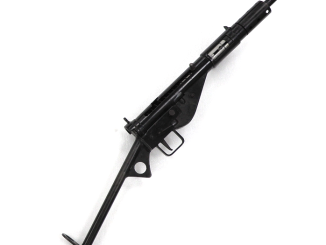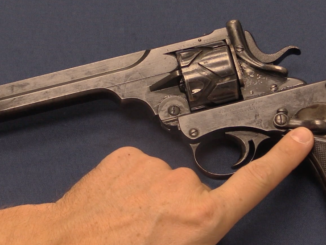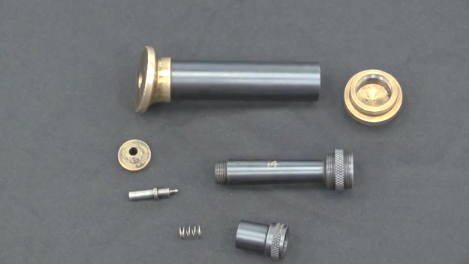The Hagen (more information here) is an early semiauto rifle designed by a Norwegian, manufactured in the UK, and tested by several different militaries – but adopted by none. It uses a long stroke gas piston and a two-lug rotating bolt to operate. Compared to other contemporary rifles, it was a quite light and sleek design, although it was a bit awkward to handle. It also had a couple neat extra features, including a magazine cartridge counter and a selector to allow either semiauto or manual operation. Unfortunately for Hagen, the lightness came at the cost of durability, and its testing in French service was ended by parts breakage.
Related Articles

Submachine Guns
Sten MkII: Just When You Thought It Couldn’t Get Simpler
The Sten MkI had barely been approved for production when the Sten MkII was born. Initially requested to produce a version of the gun suitable for paratroopers, in March 1941 Harold Turpin redesigned the front […]

Revolver
Short: Revolvers with Manual Safeties
One of the classic mistakes make by authors who are not “gunnies” is to have a character threateningly click off the safety catch…on a revolver (sound effects editors do it in movies and TV, too). […]

Video
RIA: Greener’s Humane Horse Killer
Humans have been killing animals for thousands of years, and with the development of the self-contained cartridge, the Greener company started making a compact and efficient Humane Horse Killer. Used by veterinarians for euthanizing creatures […]

“lightness came at the cost of durability”
Lightness is always desirable, but it shouldn’t be attained at any cost.
Desire for lightness backfired at Taubin – his АП-12,7 machine gun worked very poorly
http://commi.narod.ru/txt/shirad/139.htm
Engineering any good product always requires a balanced compromise between weight, strength, reliability, and so on. The rifle needs to be light enough for an ordinary foot soldier to carry on the march but durable enough for actual service in wartime conditions. Perhaps if some of the “more delicate” parts were nickel-based–alloy castings this rifle would have worked a lot better… But then we’d have created a time paradox (hint: look up the phrase “Problem solved, series over”)!
Did I mess up?
Does anyone else see any similarities between the Hagen and the Smith-Condit (a forerunner of the Standard Arms) rifle? I wonder if there was a connection? http://vintagesemiautorifle.proboards.com/thread/972/standard-smith-condit-prototype-military
It certainly looks related judging from the picture on that link you posted.
Very good design for the time, it seems less antiquated in it’s conception than some designs of it’s era. It demonstrates a more modern understanding of certain concepts, relating to functionality etc.
Trigger reach seems very similar to early Bergman pistols. Suitable for rather lazy shooters. No need to extend the trigger finger.
Complexity of machining is striking; this is pretty well with all early auto-loaders. Other than that, this is demonstration of very advanced concept, given the age. Again, super presentation.
The sight may be another clue as to it’s manufacturing origin. I have a Peddie-Parker rifle sight for a Long Lee Enfield. Stamped ‘PEDDIE Mfd BY VSM’. Further research led me to The Peddie Rifle Sight Company of Canada. He, William Peddie, held several patents for sights prior to WW1. The one fitted to the Hagen may be one of them.
I couldn’t wait to see that rifle.
It’s wonderful you could put your hands on one !
Indeed, French didn’t have a marksmanship tradition as USA. Shooting was teached in school but what was considered “good results” was to touch the silhouette at given distances. The infantry rifle was not considred to be the weapon with which a soldier shoots accurately on another soldier, but the weapon with which many soldiers shot in the direction of many other soldiers. Accuracy was not a concern. Until WWI, when it began to be considered by the officers. Then, some soldiers, called “bon tireurs” (litterally “good shooters”), were given specific rifles (with or without scopes) and were used as some kind of designated marksman.
“Does anyone else see any similarities between the Hagen and the Smith-Condit”
In terms of mechanisms rather than appearance I see it as very similar to the garand design.
It has the furniture very similar, maybe the same as the Lee Enfield.
Vickers Sons & Maxim did indeed contract manufacture many firearms not of their own design, the Pederson semiautomatic rifle & carbine and Luger pistol being two such examples as well as No.1 SMLE Rifles under contract to the British Government. Vickers Sons & Maxim were formed by the amalgamation of Vickers & Sons, the Nordenfelt Guns and Ammunition Co, & the Naval Construction and Armaments Co. In 1927 they merged again with Armstrong Whitworth and they produced a line of .22″ LR Martini actiontarget rifles.
Mud test. Better than an Ak, same or worse. The G3’s Fluted chamber may have helped make that work on Inranges mud test, the blast back over the cartridge might help remove/dry mud. Worth trying more times, to see. If so, the SA80, M16 might benefit from chamber flutes for no other reason- If they can still function with them. The SA80 might need to be on the max gas setting.
Bad idea anyway, the seven wee lugs on the rotary bolt. The G3 only has a bolt face for the gas from the flutes to hit, I still think that may actually be an advantage though- On G3 type bolts, for the reasons stated.
The SA80 does not have an adjustable gas system.
It has an adjustable gas system, it has three positions, Normal, full, off- For Rifle grenades. The gas plug turns, with a bullet tip being used to depress a plunger.
Full being used if there’s a build up of carbon before you can clean it, or general muck clogging up the system to allow in more gas to add oomph.
Want to chat about seven lugged rotary bolts? I’ll start: I know people say they improve accuracy via a more positive lock up, which they may do I don’t know. I can sort of see it… In regards consistency when chambering a round. But I don’t think that’s why they developed, I think it was just to reduce the amount of rotation required. On one or all of the Johnson rifles, can’t remember. The bolt turns inside the carrier by the cocking handle if I remember riding up a raised ledge on the ejection port, which wouldn’t generate much rotation. So given the bolt design carried over, that’s all it was about in my opinion.
I’ll level with you, I don’t like them. I think they cause the forward assist problems, via the cavernous mouths they inhabit being guarded by seven or so corresponding teeth which are hard to brush and inhibit the ability to administer mouthwash within so to speak.
Without wishing to appear like I am talking to myself, the “violent” opening on the G3 (I’m referring to a mud test carried out on the Inrange TV Full30 channel) helped achieve the impressive performance, but also the blast back out over the round scorching mud etc, generally moving it out the way via the chamber flutes did also. As did a lack of clutter I.e. A rotary bolt.
Pdb,
Recommended reading:
https://www.google.com/patents/US6044748
Note all the referenced patents for historical background on the engineering concept.
Also note some of the patents that reference this one for further development.
Increased Strength… Thanks for the patent. I have heard that before, but it’s not a powerful cartridge. I am pretty sure two AK ones would suffice, but then it would need to rotate more to cover the increased surface area.
There’s a Fosbery rifle that had a similar designed bolt. I will have a look at the information you allude to on the patent, most kind of you.
The way the M16 is constructed/layout does lend itself to having the barrel hold the locking surfaces, that’s not applicable to the SA80 though. It’s a squat lump of steel with plenty of room for adequately resilient locking surfaces to be incorporated outside of the barrel.
30.06 in the Johnson, or 7.62 Nato in the AR10 are powerful rounds compared to 5.56mm
Happen it’s using the bolt in a none tubular bolt carrier which leads to problems via it not being inline, in that in the L85/AR18 don’t have round receivers which leads to a longer bolt with the return spring in the stock area. Having a short bolt, means the bolt head sticks out over the rest of the bolt underneath it instead of it being aligned with the carrier perhaps causing wonkyness which affects the bolts alignment with the lugs slightly.
Although the M16 needed a forward assist to be added, the AR18 only saw limited use so perhaps the problem didn’t become apparent.
I wept when I saw the Em2, and it’s lovely round. Cried like a baby. Why oh why did we create that abomination the L85, from such a promising start oh lord! I called out.
Have you heard what they say on World.guns.ru:
“There’s also some rumors that infamous British SA80 / L85 assault rifle, introduced in 1980s, was based on the EM-2 design. It is not true, since the crappy L85 has nothing in common with EM-2 except for general external “bullpup” layout.”
Crappy.
Crappy, he he.
We are a floating joke!
“Being an island”
Boo hoo. Anyway this thread does have the term United Kingdom in it so I have a right to vent my spleen, done now.
Patent GB191129099A? 🙂
Nikolay,
I don’t think so. That patent shows a gas operated firearm where the breech is locked by locking lugs on what appears to be a kind of operating rod. Not sure how well this would work. The idea being that the bolt couldn’t move until the bullet passes the gas port, which then unlocks the operating rod 1911 style by pushing the locking lugs down and out of engagement with a small piston. I assume that then the residual gas pressure is somehow expected to extract and eject the cartridge. To make this work you’d probably need to add some sort of short recoil arrangement or gas booster to give the breech bolt some get-up-and-go. ^__^
https://worldwide.espacenet.com/publicationDetails/biblio?FT=D&date=19120725&DB=EPODOC&locale=en_EP&CC=GB&NR=191129099A&KC=A&ND=5
What we have on this prototype is a conventional rotating bolt, with locking lugs at the front of the bolt. The bolt being rotated by a cam track on the bolt body that we can only assume interfaces with a conventional operating rod powered by a conventional gas piston. None of those features are in the GB191129099A patent.
I just noticed that this video was uploaded to YouTube yesterday, two days after this page was posted, so I need to check it out. (Just a FYI for anyone like me who tends to have problems with the Full30 site and prefers to wait until videos are up on Youtube).
I’m also looking forward to the day when the ForgottenWeapons.com site allows people to edit and/or preview their own posts. Right now there are 27 comments — the majority made by a single person.
Good grief…
I agree that an edit feature would be of benefit, particularly for persons prone to gabbeling like myself.
https://m.youtube.com/watch?v=3WHSkbM9zAU
My solution to the SA80’s operating system is to use what I suggested for the FAMAS, affix a gas tube to the gas block. Within which an AK sytle piston sits, this is affixed to the carrier of a FAMAS type design.
The bolt would incorporate a modified lever explained below, and the carrier would be modified to house a wedge shaped plug _\ that sits behind/under the rear of the levers upper. In this position the pin would prevent the lever from moving, while it was engaged against a strengthened locking pin running through either side of the receiver through reinforced slots.
Upon firing the carrier would move rearwards slightly over the bolt, while it remained in place- The delay is down to a modification to the lever in that it’s rear upper curve would be more pronounced, extended- Imagine the pin passing through the upper curve of an S shape back to front, the longer the top of the S equates to the more time it will take for the pin to clear it allowing the lever to move. On the return the carriers pin would re-engage the ever, knocking it back so it’s lower sits behind the locking pin and its upper is engaged from the front and above once more.
Anyway, I won’t go on and on.